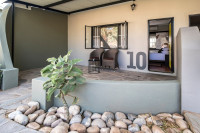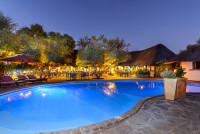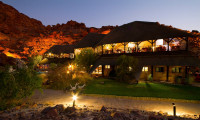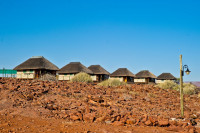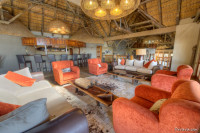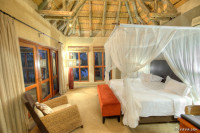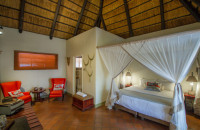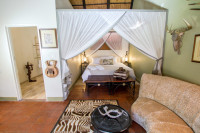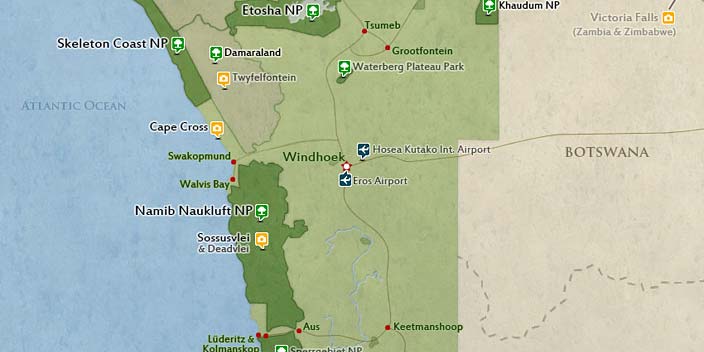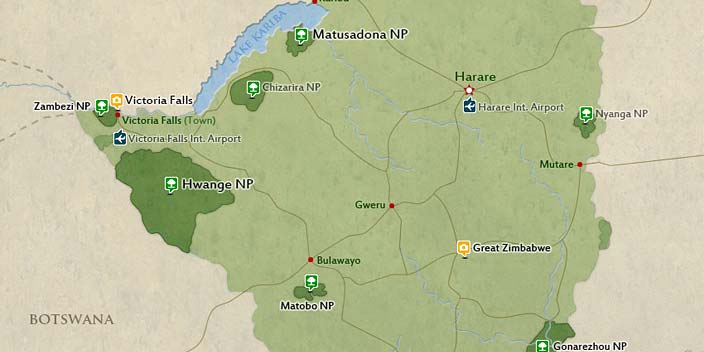
Arrival
Arrival

Day 1
Kalahari Desert
Kalahari Desert
After meeting your guide in Windhoek or the airport, you will head southwards past the towns of Rehoboth and Mariental. The Kalahari Desert covers most of Botswana and only a third of it is within Namibian Borders. The true desert of the Kalahari is experienced more on the Namibian side as there is much less precipitation compared to Botswana. This is a 4-hour drive from Windhoek including photo/scenery stops. You should be there for lunch and a bit of relaxation before the afternoon sundowner drive. Wildlife around this area includes greater kudu, hartebeest, springbok, eland, giraffe, steenbok, blue wildebeest, and ostrich among others.
- Main Destination:
- Mariental (Town, Namibia)
- Accommodation:
- Kalahari Anib Lodge
- Meals & Drinks:

Day 2
Ai-Ais Richtersveld Transfrontier Park
Ai-Ais Richtersveld Transfrontier Park
This morning you will continue your journey further southwards towards the Fish River Canyon. You will visit the Quiver Forest and Giant’s Playground on your way to the Mesosaurus Fossil Site. The Quiver Forest is a dense stand of Aloe dichotoma trees. These trees occur in southern Namibia and the Northern Cape. The giant’s playground consists of marvelous balancing dolerite (black granite) rocks. One would think they were put there by humans! This drive will take you to the Mesosaurus Fossil Site. We will see the fossils of the huge Mesosaurus that inhabited the freshwater lakes of Gondwanaland (270 million years ago). After lunch, you will proceed to our destination for the night, the Fish River. You can enjoy a sundowner before dinner. Wildlife here includes Hartmann’s Mountain Zebra, Greater Kudu, Klipspringer, Dassie, and Chacma Baboon. Special birds include karoo korhaan, karoo chat, karoo long-billed lark, black eagle, and yellow-rumped eremomela among others.
- Main Destination:
- Fish River Canyon (|Ai-|Ais/Richtersveld TP, Namibia)
- Accommodation:
- Canyon Lodge
- Meals & Drinks:

Day 3
Deep South Namibia
Deep South Namibia
Before you leave for Lüderitz, you will visit the Fish River Canyon. This canyon is the least visited Africa’s wonders, stretching about 160km and 550 meters at its deepest, it is arguably second in size to Arizona’s Grand Canyon. There are a couple of interesting xerophytic plants like the elephant trunk (Pachypodium namaquanum) and some drought-resistant succulents. Water monitor lizards frequent these pools in search of small and large-mouthed yellowfish, sharp-tooth catfish, and tilapia among other fish species. The ground squirrel, rock hyrax, chacma baboon, and klipspringer are often seen. Birds special to the canyon include olive thrush, cape robin-chat, and African black duck. You should be in Lüderitz in time to enjoy a stroll around this truly unique coastal town of Namibia. Lüderitz is famous for its delicious fresh seafood, the west-coast rock lobster (locally known as crayfish), oysters, and much-sought-after delicacy Abalone. You'll enjoy dinner if you love seafood.
- Main Destination:
- Kolmanskop (Highlight, Namibia)
- Accommodation:
- Luderitz Nest Hotel
- Meals & Drinks:

Day 4
The Succulent and Namib Karoo Biome (Sperrgebiet National Park)
The Succulent and Namib Karoo Biome (Sperrgebiet National Park)
This morning, you will visit Diaz Point and the Ghost Town of Kolmanskop before leaving for the little town of Aus where you'll spend the night. At the Diaz Point is a replica of Bartolomeu Dias, a famous Portuguese explorer who named the area Angra Pequena in 1487 before being renamed Lüderitz in honor of Adolf Lüderitz in 1884. The Ghost Town of Kolmanskop is situated in the Sperrgebiet National Park. It was named after a transport driver, Johnny Coleman who abandoned his ox wagon around this area after a fierce sandstorm. In 1908, a local worker found a diamond then the town developed quickly with an influx of fortune hunters. It became one of the richest towns in the world. It became a ghost town after more diamonds were discovered further south in today’s Oranjemund town. You'll make your way to Aus, if lucky you'll see the Desert Wild Horses. There is still a mystery of their origin and several theories have been put up. You will have a leisurely afternoon at Aus.
- Main Destination:
- Aus (Town, Namibia)
- Accommodation:
- Desert Horse Inn
- Meals & Drinks:

Day 5
Namib Desert (Namib Naukluft Park)
Namib Desert (Namib Naukluft Park)
After a relaxed morning and breakfast, you will make your way to Sossusvlei. It is quite a scenic drive past a couple of privately owned concessions and ranches with a very low human population. Animals that might be seen on the way include oryx, Hartmann’s mountain zebra, giraffe, plains zebra, and springboks among others. Photographs are worthwhile because of the background where these animals will be. After lunch at one of the most isolated places “deep in the south,” the Betta settlement, you will continue your way to Sossusvlei for the night. You will do the Namib Desert sunset game drive on the private game reserve.
- Main Destination:
- Sossusvlei (Sand Dunes, Namibia)
- Accommodation:
- Namib Desert Lodge
- Meals & Drinks:

Day 6
The Namibian Atlantic Coast (Dorob National Park)
The Namibian Atlantic Coast (Dorob National Park)
An early morning start will see you getting into the Namib Naukluft Park. The early morning light shining on the red sand dunes gives you great photographic opportunities and memories of the magnificent Namib Desert. The Namib desert has been arid for about 80 million years, with true desert conditions predominating the last 15 to 20 million years. Various wildlife thriving in this area include gemsbok, springbok, brown hyena, and black-backed Jackal among others. You will visit the most photographed sand dune in the area, Dune 45. Depending on your energy levels, climbing one of the highest sand dunes in the area, the Big Daddy, is quite fun. A visit to the Dead Vlei is worthwhile. After a visit to the Sossusvlei, you will then visit the Sesriem Canyon. After lunch, you will make your way to the Coast past scenic Gaub and Kuiseb passes.
You will go past Walvis Bay Lagoon for some interesting water birds including flamingoes. You will then stay overnight in Swakopmund.
- Main Destination:
- Swakopmund (City, Namibia)
- Accommodation:
- The Delight Swakopmund
- Meals & Drinks:

Day 7
The Namibian Atlantic Coast (Dorob National Park)
The Namibian Atlantic Coast (Dorob National Park)
After breakfast, you will embark on the Living Desert Tour activity. Dry bone, without a trace of moisture, and as dry as a weathered bone! These terms may be used to describe this unique biome with sneaky creatures that have adapted to living in harsh environments. These little creatures either camouflage or fake deaths, help in serving food on the table, or avoid being someone’s meal somehow.
This is a 4 to 5-hour tour conducted by passionate and experienced desert specialists who are desert conservationists as well. If lucky you might see the desert “Little Five”; shovel-nosed lizard, the Namib sand gecko, the Namaqua chameleon, the Namib desert sidewinding adder, and the cartwheeling spider (“dancing white lady”). Birds of interest include gray’s lark, tractrix chat, and Damara tern among others. You should be back around lunchtime and enjoy a stroll around Swakopmund city or take any optional activities that we can arrange for you in advance.
- Main Destination:
- Swakopmund (City, Namibia)
- Accommodation:
- The Delight Swakopmund
- Meals & Drinks:

Day 8
Skeleton Coast National Park and Damaraland
Skeleton Coast National Park and Damaraland
You will leave the Coastal environment and drive inland past a couple of shipwrecks. You will visit the Cape Cross Seal Reserve. This is a 60 km2 reserve and has the largest seal colony in the world, with numbers up to 240,000 at a given time. After this activity, you will then go through the Skeleton Coast National Park. The Namibian Skeleton Coast National Park is renowned for its cold and unpredictable Benguela Current of the Atlantic Ocean that contends with the dune and desert landscape. It is described as the world’s largest ship cemetery because of various shipwrecks found along the coast. Wildlife here includes oryx, springbok, black-backed jackal, ostrich, brown hyena, desert-adapted elephant, black rhino, and lion. Because of the harshness of the area, these animals do not occur in huge numbers and are not very easily spotted, so let’s keep our eyes peeled. You will stay overnight in the Damaraland Twyfelfontein region.
- Main Destination:
- Twyfelfontein (Rock Art, Namibia)
- Accommodation:
- Twyfelfontein Country Lodge
- Meals & Drinks:

Day 9
Palmwag Concession (Kunene Region)
Palmwag Concession (Kunene Region)
This morning you will visit the Bushman Rock Engravings around Twyfelfontein before making your way to Palmwag Concession. The Twyfelfontein area was declared a UNESCO World Heritage Site in 2007 and consists of over 40,000 rock engravings done by the San people 2000 years ago. It is a 45-minute walk conducted by local guides. Afterward, you will search for desert-adapted elephants in your own vehicle in the ephemeral riverbeds and enjoy your packed lunch. The drive to Palmwag goes past local villages that share the environment with wildlife, so we are not in a designated national park. Various wildlife may be encountered including oryx, giraffe, Hartman’s mountain zebra, springbok, and black rhino among others. Birds include Namibian near endemics, rappel’s parrot, rappel’s Korhaan, Monteiro’s hornbill, Damara red-billed hornbill, Benguela long-billed lark, white-tailed shrike, Bokmakierie among others.
- Main Destination:
- Palmwag (Damaraland, Namibia)
- Accommodation:
- Palmwag Lodge
- Meals & Drinks:

Day 10
Palmwag Concession (Kunene Region)
Palmwag Concession (Kunene Region)
An early morning starts with a packed breakfast, you will head out in search of a desert-adapted black rhino. You will be taken by local guides and rhino rangers. The Namib Desert is home to the last truly wild stronghold of black rhinos. This activity involves 4 x 4 driving in rugged terrain and walking safari to get to the rhinos if lucky. These mammals are not in a fenced area but in an open ecosystem. It is a joint venture of the Namibian Ministry of Environment and Tourism, the communities, Save Rhino Trust, and other Non-Governmental Organizations in the conservation of black rhinos. The program of community-based natural resource management seeks to empower people living in rural areas to manage and benefit from their natural resources.
This activity might take the whole day, however, there is still a possibility of a late afternoon sundowner drive in your own vehicle.
- Main Destination:
- Palmwag (Damaraland, Namibia)
- Accommodation:
- Palmwag Lodge
- Meals & Drinks:

Day 11
Etosha National Park Southern Side
Etosha National Park Southern Side
After a relaxed morning and breakfast, you will head to the southern part of Etosha National Park. After lunch either enroute or upon arrival at the lodge you will relax. Late afternoon, you will depart for a game drive in the park in your own vehicle. The game and birds found in this park are typical of the savannah plains of southern Africa but also include several species endemic to this western side of the continent, adjacent to the Namib Desert. Depending on the time of the year, the number of antelopes around waterholes is amazing. Common wildlife includes elephant, giraffe, eland, blue wildebeest, greater kudu, springbok, black-faced impala, diminutive Damara dik-dik, and plains zebra among others. Predators include lions, leopards, cheetahs, spotted hyenas, and black-backed jackals among others. You will notice here the slight difference between elephants compared to the desert-adapted elephants.
- Main Destination:
- Etosha National Park (Namibia)
- Accommodation:
- Etosha Safari Lodge
- Meals & Drinks:

Day 12
Etosha National Park Eastern Side
Etosha National Park Eastern Side
You will have a full-day game drive in your own vehicle. This includes a lunch stop somewhere in the park. Etosha National Park is semi-arid hence animals depend on contact springs, water level springs, artesian springs, and a couple of man-made waterholes for water. Etosha means “Great White Place” in the local Oshindonga language, referring to the 4800 km2 salt pan that covers 23% of the park’s surface area. Mammals include black and white rhinoceros, lion, leopard, cheetah, African elephant, plains and Hartmann’s mountain zebras, southern giraffe subs angolensis, eland, gemsbok, African wild cat, spotted and brown hyena among other animals. It is quite unique in its own way as the concentration and diversity around waterholes in the dry season are magnificent, giving one a chance to see animal dramas unfolding as they take turns to quench their thirst. You will be visiting these waterholes all day long as you drive from the southern to the eastern part of the park.
- Main Destination:
- Eastern Etosha National Park (Namibia)
- Accommodation:
- Mushara Lodge
- Meals & Drinks:

Day 13
Etosha National Park Eastern Side
Etosha National Park Eastern Side
You will have more of a relaxed day of morning and afternoon game drives in the eastern part of Etosha, with a 3-to-4-hour break in between. This implies you will be back at the lodge around mid-day and go back in the late afternoon. You will enjoy the siesta or swimming pool and the tranquility of the lodge. Besides mammalian diversity, 340 bird species are known to occur in Etosha National Park. About a third are migratory including European bee-eaters, and several species of waders. Ten of Etosha’s 35 raptor species are migratory. Those most commonly seen are lappet-faced vultures, white-backed vultures, hooded vultures, and on very rare occasions, Cape, Egyptian, and Palm-nut vultures have been recorded. 8 species of owls have been recorded, including pearl-spotted owlets and white-faced scops-owl.
- Main Destination:
- Eastern Etosha National Park (Namibia)
- Accommodation:
- Mushara Lodge
- Meals & Drinks:

Day 14
Bwabwata National Park (Mahango Core Area)
Bwabwata National Park (Mahango Core Area)
After breakfast, you will make your way to the northeastern part of Namibia. This a whole day of driving as you enjoy the sudden change of scenery from the desert to the wetlands. The Bwabwata National Park is 6100 km2 and includes the Mahango, buffalo, and kwando (Golden Triangle) core areas. It forms part of the KAZA (Kavango Zambezi) Transfrontier Conservation Area which is the world's largest conservation area that incorporates joint management from 5 countries: Namibia, Botswana, Angola, Zimbabwe, and Zambia. The part of the park is zoned for community-based tourism including human settlement and development. Mammals include elephant, buffalo, reedbuck, red lechwe, sitatunga, hippopotamus, Tsessebe, sable antelope, roan antelope, Chobe bushbuck, lion, leopard, cheetah, African wild dog among others. Compared to Etosha elephants which tend to have shorter and broken tusks, elephants here have much longer tusks.
- Main Destination:
- Mahango Game Reserve (Zambezi Region, Namibia)
- Accommodation:
- Divava Okavango Resort & Spa
- Meals & Drinks:

Day 15
Bwabwata National Park (Buffalo Core Area)
Bwabwata National Park (Buffalo Core Area)
You will do a morning game drive in the Mahango Core Area (245 km²). You will then come back for relaxation around the lodge and enjoy your lunch. You will then go for an afternoon game drive in the Buffalo Core Area (629km²). The Mahango Core Area is located on the west side of the Okavango River. Because of the lack of surface water, wildlife is mainly found along the Okavango River (Kavango River as Kavango people prefer calling it on the Namibia side). Elephants, buffalos, zebras, and wildebeests do seasonal movements. They remain around the Okavango River during the dry season and move inland during the wet season. This seasonal cycle is an important natural mechanism that guarantees that the vegetation structure can be in a resting period during some part of the year. A part of the Buffalo Core Area is situated in the ruins of an old South African army station, so one will be looking at the old deserted buildings. Ironically there is lots of game around this part of the park.
- Main Destination:
- Bwabwata National Park (Zambezi Region, Namibia)
- Accommodation:
- Divava Okavango Resort & Spa
- Meals & Drinks:

Day 16
Bwabwata National Park (Kwando Core Area)
Bwabwata National Park (Kwando Core Area)
This morning before you leave for a 3-hour drive to Kwando Core Area, you will do a morning boat cruise on the Okavango River. Besides mammals, the birding is excellent in this area as it is also recognized internationally as an Important Bird Area to support bird species that are endangered or threatened. Some of the highlight species include the wattled crane, African pygmy goose, coppery-tailed coucal, Southern ground hornbill, Bennett’s woodpecker, wood owl, white-backed night heron, African skimmer, brown fire finch, and rare vagrants like the Northern carmine bee-eater. The Kwando River has several names, Kwando in Namibia, Linyati in parts of Botswana, and Chobe in the Kasane area in Botswana. This part of the park serves as the main migration corridor of wildlife between countries, hence has a huge concentration of game. The Kwando River is different from Okavango which comprises a network of oxbows, some of which are several kilometers away from the river's current course.
- Main Destination:
- Bwabwata National Park (Zambezi Region, Namibia)
- Accommodation:
- Namushasha River Lodge
- Meals & Drinks:

Day 17
Chobe National Park (Botswana)
Chobe National Park (Botswana)
After breakfast, you will take a leisurely Namibia wrap-up drive through Mudumu National Park, past a couple of Conservancies, and cross the border into Botswana’s Chobe National Park. Mudumu National Park is a 1010 km2 expanse of dense savannah and mopane woodlands bordered in the west by the Kwando River. This park is alive with more than 400 bird species and a home to a small population of elusive Sitatunga. Chobe National Park (11700 km2) is Botswana's first national park, and also the most biologically diverse as it encompasses floodplains, swamps, and woodlands. The park is widely known for its large elephant population (around 50,000) hence they tend to congregate in huge numbers up to 200 at a given time. Other mammals include red lechwe, puku, roan and sable antelopes, Chobe bushbuck, vervet monkey, and Chacma baboon, along with the accompanying predators such as lion, leopard, hyena and black-backed jackal. You will be in time for the renowned Chobe River sunset boat cruise.
- Main Destination:
- Chobe National Park (Botswana)
- Accommodation:
- Chobe Safari Lodge (Botswana)
- Meals & Drinks:

Day 18
Chobe National Park (Botswana)
Chobe National Park (Botswana)
An early morning start will take you to Chobe National Park. About 460 bird species have been recorded in the park, which includes common species like sacred ibis, Egyptian goose, white-breasted cormorant, African darter, spur-winged goose, Pel's fishing owl, Southern carmine bee-eater, most members of the kingfisher family, all 5 species of rollers in southern Africa, the unmistakable fish eagle, martial eagle, bearded scrub-robin, collared palm thrush and many more. You will maximize your game viewing time here by embarking on an afternoon game drive as well.
- Main Destination:
- Chobe National Park (Botswana)
- Accommodation:
- Chobe Safari Lodge (Botswana)
- Meals & Drinks:

Day 19
Victoria Falls (Zimbabwe)
Victoria Falls (Zimbabwe)
After a morning activity, you will cross the border into Zimbabwe’s Victoria Falls. It’s a short distance of an hour's drive through Matetsi Safari Area to the small town of Victoria Falls that lies within Victoria Falls National Park. So, we are not in a hurry “Hakuna Matata”! You will visit Victoria Falls which is one of the world's largest waterfalls, with a width of 1,708 m (5,604 ft.). It is a riverine habitat containing plants rare for the area such as pod mahogany, ebony, ivory palm, wild date palm, batoko plum creepers, and lianas. The rich avifauna, over 400 species in the Victoria Falls region as a whole, includes white-browed robin-chat, Knysna turaco, and trumpeter hornbill in the Falls 'rainforest' area. Found above the Falls are the white-backed night heron, African finfoot, and rock pratincole.
The Taita falcon (rare but widespread in eastern and central Africa) breeds in the gorges, as do the black stork, black eagle, peregrine falcon and augur buzzard.
- Main Destination:
- Victoria Falls (Zimbabwe)
- Accommodation:
- Nguni Lodge
- Meals & Drinks:

Day 20
Victoria Falls (Zimbabwe)
Victoria Falls (Zimbabwe)
This is quite a leisure day of relaxing and reflecting on your “desert to wetlands” expedition in Southern Africa. However, there are various optional activities depending on the spirit of adventure and bucket list:
Helicopter flights over the Falls
White-water rafting (depends on the season)
Bungee jumping
Zambezi sundowner boat cruise
If willing to do any optional activity, do not hesitate to let us know in advance so we can arrange it accordingly.
- Main Destination:
- Victoria Falls (Zimbabwe)
- Accommodation:
- Nguni Lodge
- Meals & Drinks:
Day 21
Victoria Falls Airport
Victoria Falls Airport
This marks the end of your trip, and you may connect your flight from the Victoria Falls International Airport.
- Main Destination:
- No major destination visited
- Accommodation:
- No accommodation (End of tour)
- Meals & Drinks:

































